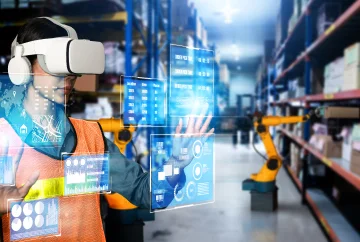ERP vendors have begun offering some rudimentary automation capabilities to orchestrate business processes faster in their latest offerings. In addition, evolving architectural paradigms now enable ERP systems to integrate seamlessly with other enterprise technology systems like Customer Relationship Management (CRM), Supply Chain Management (SCM), Business Intelligence (BI), Point of Sale (POS) systems, and other platforms.
This has turned ERPs into digital hubs of critical, and most relevant business data. In light of one of the key revolutions of the 21st century – i.e., big data technologies like Artificial Intelligence (AI) and Machine Learning (ML), ERP systems are due for their next stage of evolution. This evolution will be unleashed by bringing AI and ML capabilities into ERP environments, to achieve more intelligent and autonomous business operations.
A pressing need for reinventing ERP systems
Post 2020, organizations across the globe have experienced unprecedented challenges in their supply chain and production planning strategies. Macroeconomic factors and market forces now require businesses to be more agile, responsive, and data-driven across vital processes in their business operations.
Despite bringing powerful digital capabilities, existing ERP systems fall short in this regard. Why? Key processes like order-to-cash, make-to-deliver, and record-to-report remain largely manual and require significant data crunching for effective decision-making. Moreover, in the absence of real-time analytics, key personnel across functions make critical decisions using outdated data or lack the required information to make effective decisions. Here are two examples of such scenarios:
- Regional operations heads are unable to account for the impact of currency fluctuations on profit margins in distributed order fulfillment.
- Manual finance and inventory reconciliation requires significant time and effort and delays month-end reporting.
- Shipment tracking data is available outside the ERP environment, making it difficult to track the fill rate across all orders.
- High order cancelation volume erodes profit margins, and blanket efforts to address customer churn fail to address such issues.
Considering that AI and data engineering solutions are now available to solve such problems, AI adoption in ERP is a significant opportunity waiting to be realized for most organizations.
Scoping the potential of AI and ML in ERP
Modern ERP systems are highly customizable, and this is one factor that enables businesses to implement targeted use cases of AI within ERP environments. The upside of implementing AI within ERP systems is that they enable enterprises to deliver insights at the point of action at scale.
Consider the following key outcomes which businesses can achieve by adopting AI and ML in ERP:
- Increasing order fulfillment rate and free cash flow, and reducing canceled orders in the order-to-cash process.
- Maximizing in-budget and on-time purchases, and lowering supplier defect rate in the procure-to-pay process.
- Improving on-time delivery rate, perfect order rate, and capacity utilization in the make-to-deliver cycle.
- Lowering cost and spend, and achieving faster month-end in the record-to-report process.
AI and ML levers in ERP environments
How are the above outcomes achieved? Here are some of the key levers that enable businesses to realize these gains with AI and ML adoption in ERP:
- Predictive capabilities: ERP systems support key processes in demand planning, procurement budgeting, production planning, and order fulfillment. Some of the data required to make these decisions is already present in the ERP and other systems like SCM and PoS. This can be supplemented with real-time macroeconomic and market data to enable more precise forecasts, which, in turn, support better decision-making in the above processes. For example, demand planners can simulate multiple scenarios to predict demand change and update demand forecasts in response to real-time data.
- Prescriptive analytics: Prescriptive techniques deliver relevant recommendations to the right users and enable them to achieve the desired outcome. For example, ML models can recommend optimal order routes or prescribe updated credit limits for customers based on their changing credit scores. Similarly, AI algorithms can prescribe corrective actions to reconcile finance and inventory data or mitigate issues found during automated financial audits.
- NLP-powered features: Natural Language Processing (NLP) capabilities enable users to quickly locate the right information or sift through a high volume of verbal data in seconds. For example, a sales executive who has to read through specification sheets of tens of products to recommend the right one to a client can write a natural language query in a search box to find the right product. Such capabilities can speed collaboration and help users complete time-consuming processes in minutes.
- Hyper-automation: Hyper-automation is one of the most promising outcomes that can be realized through AI and ML in ERPs. This refers to the use of AI to automate processes that otherwise require human intelligence. For instance, we can apply AI algorithms to orchestrate order routing at scale or reconcile online transactions underpinning customer orders with logistics partners. This can help cut down the time to complete a process by more than half in some cases.
- User experience personalization: Finally, AI and ML applications are also enabling organizations to deliver a more personalized experience to employees. With role-based dynamic dashboards that show the most relevant data and insights to each user, employees can focus their efforts on the most critical action items every day.
AI Adoption in ERP: Key Challenges and the Way Forward
Considering the strategic gains that can be realized with AI and ML in ERP, organizations that have already implemented ERP solutions should strongly consider adopting this technology in their ERP environments.
However, a well-strategized approach should be paired with thorough planning, considering the following challenges of AI adoption in ERP:
- Data quality will strongly impact the outcomes of any AI use case implemented in an ERP. Therefore, ensuring high-quality data and harmonizing it across all systems, including ERPs, is important.
- AI use cases may require integrations with other ERP modules or other systems. Any changes across these systems may impact model performance, so continuous model training may be required.
- AI and ML implementation in ERP is likely to change existing business processes and workflows. As a result, users may require training to encourage adoption and realize the envisioned benefits.
- Because ERPs contain sensitive data that may be subject to data privacy and security regulations, adequate attention must be paid to these factors before initiating pilots.
- Lastly, AI and ML technologies are undergoing constant evolution. If your organization lacks a highly skilled technology team and reliable leadership, it’s best to engage a technology partner who has already delivered AI and ML implementations in ERP environments.



